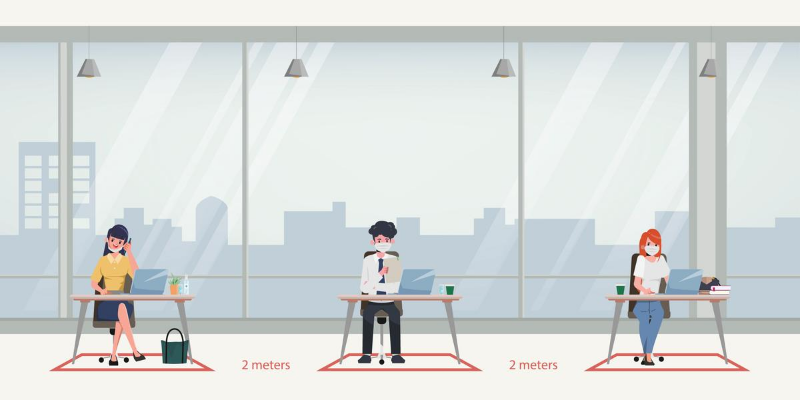Work from home fatigue is real, and most of us cannot wait to return to our workplaces. However, even after the anxiety of stepping out and travel is overcome, we know that the post-COVID-19 workspace will not be the same.
Business revival may be at the top of the mind for companies, but it will not be possible unless employee health and safety become the utmost priority. Precautions and hygiene protocols will need to be top-notch to build confidence amongst employees to return.

Hygiene must be comprehensive
People use the terms cleaning, sanitising, and disinfection interchangeably, but each one is distinct, and none of them in isolation is sufficient. While cleaning removes dust and grime, sanitising involves bacterial reduction and pest control. Finally, disinfection destroys or deactivates microorganisms.
The lockdown, along with the summer heat and monsoon humidity, will have led pest colonies in all workplaces to multiply. At the same time, you might encounter fungus and dangerous black mould in and around refrigerators, damp spaces, and water accumulation spots. The space we once shared would have been taken over by various invasive live forms. An initial blitzkrieg to control pests, followed by a scientific approach will be necessary to manage all breeding areas.
In this war against COVID-19, we cannot discount the risks posed by other microbial pathogens. A thorough disinfection routine will need to be set at the appropriate cadence to keep the premises safe.
Using non-toxic, preferably herbal and allergen-free, options for these services will be of paramount importance to assure employee wellness.
The sudden explosion of demand has unfortunately led many local players to offer these services without appropriate precautions and protocols. Do check if the professionals hired have the wherewithal and capability to treat your workspace comprehensively.
Implement multiple lines of defence
While the rules of quarantining will need to be adhered to, workplaces will benefit by developing various lines of defence against infection.
The first line of defence will start at employees’ homes, where each employee will be asked to self-quarantine for a stipulated period if they experience any symptoms or come in contact with a patient or even senses a risk. We will need everybody to be honestly sensitive and accountable towards this.
The second line of defence is at the workplace entrance, where each person is checked for key parameters and symptoms like temperature, heart rate, and oxygen levels before being allowed to enter. Test equipment for these parameters are surprisingly quick and efficient.
The third line of defence will be the compulsory usage of protective gear – including masks, gloves, and sanitisers – to ensure that the spread is minimised even if it does cross the first two lines to enter workspaces. Having the disinfection partner continuously protect all high-touch areas like door handles, lift buttons, staircase rails, etc., will also be critical.
Lastly, an isolation room will be needed in all offices to quickly quarantine anybody who feels unwell. A designated doctor-on-call is a must.
Staggered and contact-less revival
Switch to a hot-seat concept where seating is no longer designated. Distance seating can be ensured by employees taking turns in using office space on alternate days. Besides, self-quarantining and employees who shifted to hometowns will automatically help reduce workplace density.
We will need to make the workplace as contactless as possible. Automatic tea dispensers instead of brewing tea, washroom doors than open with the foot, foot-pedal sanitiser dispensers, and printers with remote printing options are a given.
Aerosol studies have proven that the risk in open areas is substantially lower than in closed rooms, especially where the HVAC system recirculates the air.
Reconsider central ACs, see if an area can benefit from natural air ventilation. Regular deep cleansing of areas around the HVAC will also have to be taken up. Air filters need to be cleaned, ducts sanitised, and the entire system checked.
Crowd-source support from employees
None of the above is possible without the wholehearted support of teams and their respective families. Over-communication of the rationale and process transparency will be key. The safety and precautionary measures will help put their minds at ease.
Genuine care shown during a crisis goes a long way in building trust and comfort levels of employees. It will be remembered in the times to come. Vitamin supplements, immunity boosters for employees and their families, and special disinfection packages for homes and vehicles can be considered.
This is a change management project, which will have to be handled with optimism, care, and expertise at all levels.
(Edited by Saheli Sen Gupta)
(Disclaimer: The views and opinions expressed in this article are those of the author and do not necessarily reflect the views of YourStory.)
Want to make your startup journey smooth? YS Education brings a comprehensive Funding Course, where you also get a chance to pitch your business plan to top investors. Click here to know more.
Link : https://yourstory.com/2020/08/contactless-sanitised-post-covid-19-workspaces
Author :- Sumit Nadgir ( )
August 22, 2020 at 08:45AM
YourStory


